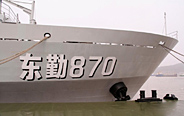

Fifty minutes prior to the impact, the spacecraft fired their engines until the propellant was depleted. The maneuver was designed to determine precisely the amount of fuel remaining in the tanks. This will help NASA engineers validate computer models to improve predictions of fuel needs for future missions.
The mission team has deduced that much of the material aboard each spacecraft was broken up in the energy released during the impacts. Most of what remained probably is buried in shallow craters. The craters' size may be determined when NASA's Lunar Reconnaissance Orbiter returns images of the area in several weeks.
When launched in September 2011, the probes were named GRAIL A and B. They were renamed Ebb and Flow in January in a nationwide contest. Ebb and Flow were placed in a near-polar, near-circular orbit at an altitude of approximately 34 miles (55 km) on Dec. 31, 2011, and Jan. 1, 2012, respectively.
 |  |
 Weekly review of military photos (2012.12.10-12.14)
Weekly review of military photos (2012.12.10-12.14) Chinese naval ships use new-type hull numbers
Chinese naval ships use new-type hull numbers PLA marines in amphibious armored training
PLA marines in amphibious armored training Palestinians hold rally for release of prisoners
Palestinians hold rally for release of prisoners Japan's Abe attends press conference in Tokyo
Japan's Abe attends press conference in Tokyo  Fraud suspects returned to mainland from Taiwan
Fraud suspects returned to mainland from Taiwan Roam in old time of Luoyang
Roam in old time of Luoyang More luxury hotels take shark fin off their menu
More luxury hotels take shark fin off their menu China's weekly story (2012.12.10-12.15)
China's weekly story (2012.12.10-12.15) Christmas Wedding Expo closes in Hong Kong
Christmas Wedding Expo closes in Hong Kong The spending of China's rich
The spending of China's rich Black-necked cranes fly over Nianhu Lake
Black-necked cranes fly over Nianhu Lake Go ice skating! Let's have fun in Taoranting Park
Go ice skating! Let's have fun in Taoranting Park Biking, a fabulous sport
Biking, a fabulous sport 8 fantastic photo ideas you can do right now
8 fantastic photo ideas you can do right now